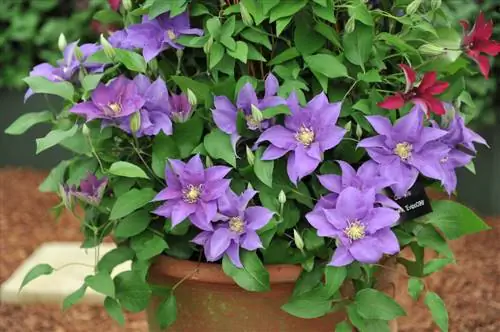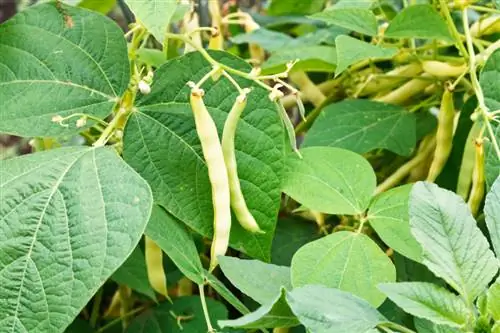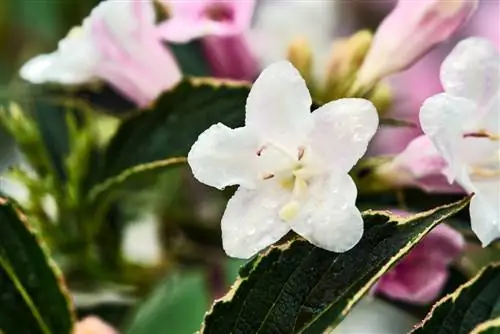- Author admin [email protected].
- Public 2023-12-16 16:46.
- Last modified 2025-01-23 11:20.
The clematis or clematis not only grows in the garden, but can also be cultivated on the balcony or terrace. Read which varieties are suitable for the pot and how to plant and care for them correctly for he althy growth.

Which clematis to choose for the pot?
Which clematis varieties are suitable for containers? Clematis viticella varieties such as 'Hanna', 'Polonez', 'Marmori', 'Mikelite' and 'Dark Eyes' are particularly suitable for the pot, as they reach a maximum height of two meters and bloom in summer.
Which clematis is suitable for pots?
Basically, all types and varieties of clematis that are no higher than two meters are suitable for the pot. Here you will find a large selection, especially of the Italian clematis (Clematis viticella):
- ‘Hanna’: violet-blue bell-shaped flowers
- ‘Polonez’: wine-red flowers
- ‘Marmori’: light pink marbled flowers
- 'Mikelite': violet-red flowers
- ‘Dark Eyes’: dark purple-violet flowers
The advantage of these varieties is that they are summer-flowering, meaning they produce new flowers continuously between June and September.
Furthermore, you can use varieties for pot cultivation that are sensitive to frost and therefore cannot be planted in the garden. Of course, this only works if you can overwinter the plants frost-free.
How big does a pot have to be for clematis?
After the most beautiful clematis has been selected for the pot, you should start looking for a suitable planter. This should have these properties:
- Volume of at least 20 liters, preferably larger
- made of durable, heavy material such as ceramic, terracotta or clay
- if possible in light colors, no black
The bucket should be as large as possible so that it can hold a lot of soil. After all, a larger amount of soil also contains more nutrients, and it doesn't dry out as quickly on hot days and doesn't freeze as quickly in winter. You should avoid plastic pots as they are unstable and tip over more quickly. Black pots, on the other hand, heat up faster, which clematis don't like.
Which clematis varieties should not be planted in pots?
Basically, all clematis that are significantly higher than two meters are unsuitable for the pot. For these specimens you would have to purchase very large pots, which would be very heavy due to the large amount of soil - this could in turn have a negative impact on the statics of the balcony, and these containers can hardly be moved. In addition, tall clematis in pots are difficult to provide with sufficient water and nutrients. The species Clematis montana, whose varieties can grow up to eight meters high, is particularly unsuitable.
How often should you water and fertilize a clematis in a pot?
Clematis only feel comfortable in pots if they are watered and fertilized regularly. If there is a lack of water and nutrients, the plants quickly starve and do not produce flowers. Regular watering, especially in the summer months, is therefore essential, although the substrate should always be kept slightly moist. However, be sure to avoid waterlogging as this leads to root rot - drainage and drainage holes in the pot must not be missing. Fertilize every two to four weeks with a liquid fertilizer for flowering plants (€8.00 on Amazon).
Tip
Is clematis hardy in pots?
Even winter-hardy clematis varieties need some protection in winter so that the roots don't freeze. Place the pot on a thick surface, e.g. B. made of wood, wrap it with fleece or something similar and push it against a wall. Clematis that are not hardy should overwinter cool but frost-free.






